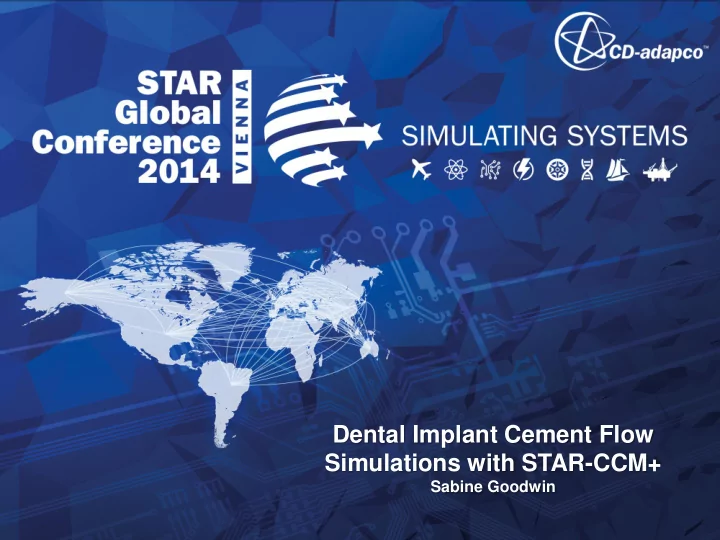

Dental Implant Cement Flow Simulations with STAR-CCM+ Sabine Goodwin
Problem Description Missing teeth are replaced by implants and crowns It is now common place for dentists to join crowns and implants using cement (as opposed to using screws) – Improved esthetics – Cost-effective – Reduced chair-time Excess cement extrusion into the soft tissue has been shown to cause long- term peri-implant disease
System Control Solution Only very limited data is available on how to achieve optimal cementation and avoid these health issues Questions to ask : – How much cement should be used? – What type of cement should be used? – Where should the cement be loaded in the crown? – Can the implant shape be changed? System control solution : consider the complete implant abutment, cement and crown system
Simulating the System STAR-CCM+ is well-positioned and can address these problems – Understand cement flow patterns of the system – Explore effects of • Amount of cement • Initial cement placement • Speed of crown seating – Re-design implant to retain excess cement within the implant abutment Key features of STAR-CCM+ : – 3D-CAD – Overset Mesh – Volume of Fluid (VOF) Multiphase Model – Optimate Powered by HEEDS
Non-Newtonian Properties of Cement Dental cements are non- Newtonian in nature – Viscosity varies with shear rate – RelyX ™ cement is shear thinning (viscosity decreases with shear rate) Source ce : http tp:/ :// portal.daledental.com/files/proddocs/11/RelyX%20ARC%20Technical%20Profile.pdf STAR-CCM+ offers several models for simulating non-Newtonian laminar liquids – Herschel-Bulkley model for Bingham plastics is commonly used – Input parameters for model were obtained through curve fitting of the RelyX ™ cement viscosity vs. shear rate properties Parameters for Herschel-Bulkley model provided by Nathanael Inkson (CD-adapco)
Implant and Crown Simulation Setup Cross-sectional cut through implant, crown and cement system Overset Mesh Approach – Polyhedral mesh – Significant refinement to capture free surface and small gap at end position – Background region for implant is stationary – Overset region translates down to reflect motion of the crown Initial cement loading – ½ toroid shape, 1 mm radius – Located just above margin line – Defined using a scalar array of volume fraction Simulation – Transient solution – VOF (air/cement) – Laminar flow/Segregated solver – Non-Newtonian fluid – Spans 0.5 seconds from starting to ending position 100% Cement 100% Air
Animation of Implant Abutment & Crown System
Abutment modifications : Experimental Studies Implant design : what are we looking for? – Minimal amount residual excess cement enters the surrounding soft tissue results in reduced peri-implant disease – Large contact area between cement/implant and crown results in greater retentive capability – Crown/Implant margin needs to be sealed Studies performed on three types of abutments : – Closed abutment – Open abutment – Internal vent abutment In-vitro experimental study results : – Leaving screw access hole open improves cement retention – Internal vent abutment shows a better infill of the screw access hole Weight of cement mg. 0.15 0.1 0.05 0 Closed Open IVA Abutment modification
Abutment Modifications : STAR-CCM+ Simulations Open Abutment – Screw access chamber is left open • Provides a reservoir for excess cement to be retained inside abutment system – Leads to : • Less cement extrusion – Reduced peri-implant disease – Easier and faster clean-up • Improved retentive capabilities from increased contact area Internal Vent Abutment – Screw access chamber is left open – Two additional round vents • 2.5 mm below occlusal surface • 180 degrees apart • 1 mm in diameter – Leads to : • Further control over cement flow • Improved retentive capabilities from increased contact area
Abutment Modifications : STAR-CCM+ Validation Open Abutment Internal Vent Abutment Closed Abutment 100% Cement 100% Air
How much cement should be loaded? ~30 mm 3 ~35 mm 3 ~45 mm 3
How much cement should be loaded? Amount of cement : ~45 mm 3 Amount of cement : ~35 mm 3
What application technique should be used? Cement loaded at crown margin : Cement loaded near occlusal surface: • Vents fill up before the screw • Screw access hole fills up first access hole. • Cement is pushed with force • Overall flow of cement is smooth through the vents • No cement leaves the system. • Results in an incomplete margin seal
What application technique should be used? Closed abutment with cement loaded near occlusal surface Close abutment with cement loaded at crown margin
How fast should the crown be seated? Slow : 1 second for seating Fast : .25 seconds for seating
Conclusion STAR-CCM+ was used to investigate the problem of excess cement extrusion that leads to peri-implant disease Simulation of the complete implant, cement & crown system showed: – Good comparison with experimental studies : internal vent abutment is the best design – Amount of cement loaded matters! – Loading cement near the implant crown margin reduces residual excess cement – Speed of seating of crown matters! Future work – Continue current research – Expand to other application such as cementation during hip replacements
Recommend
More recommend